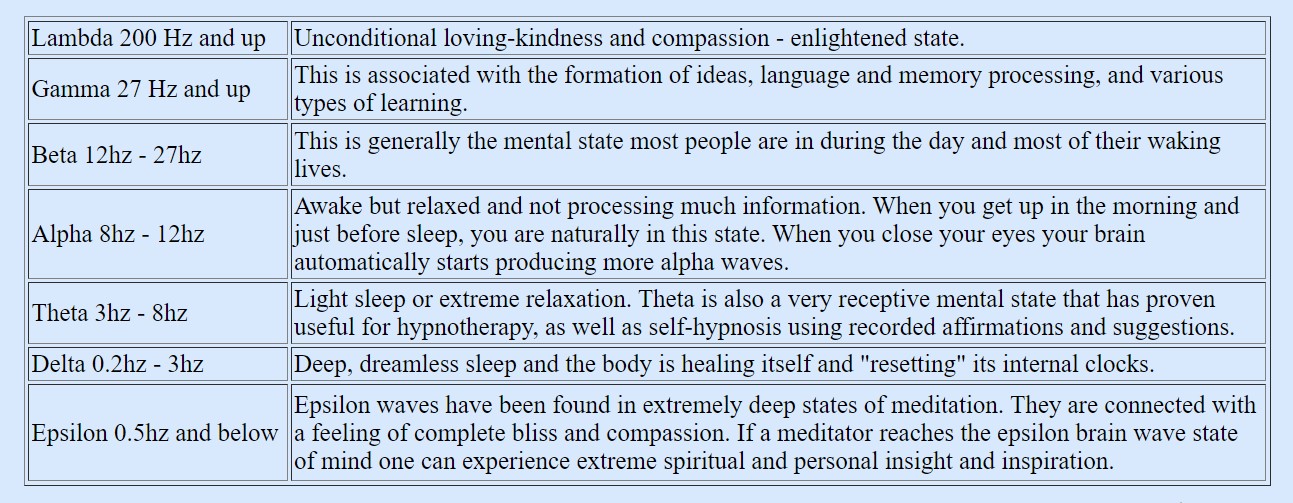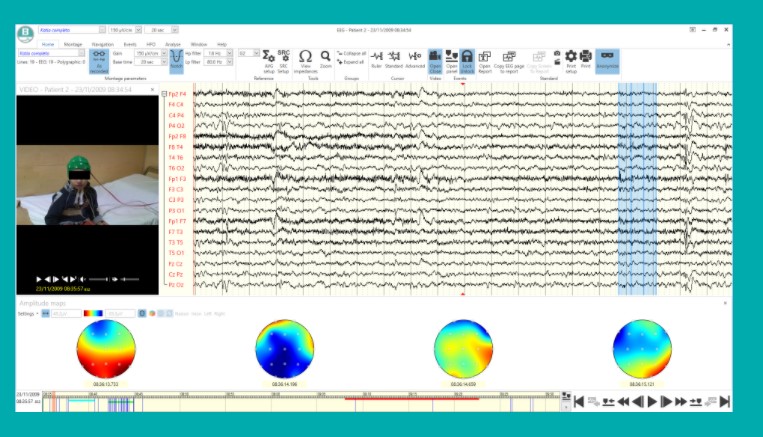Brainwave
Manipulation
Electroenephalography (EEG) is
the measurement, in real-time, of brain waves. It requires the use of
electrodes that are placed on the scalp. An amplifier and a
visualization software are then used to graph the brains electrical
activity.
EEG
graphing hit the mainstream recently. The non-invasive sensors are
placed on the scalp and forehead. Clinical-grade caps include far
more sensors than their cheap counterparts and pick up electrical
activity from the 8 major brain regions, which are: the frontal,
parietal, occipital and temporal lobes, as well as the limbic system,
the brain stem, the cerebrum and cerebellum.
Together,
these eaves-dropping sensors give us a picture of whats going on in
someones head in real time.
 The
Monroe Institute founded more than 30 years ago by Robert Monroe,
pioneered an auditory method for alternate brainwaves, using
Bianaural Beat technology. Monroe and his students claim that by
using binaural beats in controlled conditions, we can learn to access
higher states of consciousness, leave our bodies and engage in
boundless astral
travel. While this claim is quite radical, the therapeutic
power of brain entrainment using binaural technology is not.
The
Monroe Institute founded more than 30 years ago by Robert Monroe,
pioneered an auditory method for alternate brainwaves, using
Bianaural Beat technology. Monroe and his students claim that by
using binaural beats in controlled conditions, we can learn to access
higher states of consciousness, leave our bodies and engage in
boundless astral
travel. While this claim is quite radical, the therapeutic
power of brain entrainment using binaural technology is not.
Clinicians have learned not
just to measure but to also manipulate brainwaves in non-invasive
ways. In Neuropsychology, therapists use methodologies like LENS,
Transcranial
Magnetic Stimulation, or learning-based neurofeedback,
to alter undesirable brain states. These methods can help people with
a myriad of issues like chronic pain, anxiety, depression or PTSD.
Specification of EEG
Machine
Input Impedance – 100
Mega Ohms
Input/Noise - <1.5 micro V
p-p
Sampling Rate – 1000 Hz
or more
Bandwidth – 0.0x –
300 Hz (600)
Channels – 32, 64 +2 ECG
Analog/Digital Conversion –
24 bits
Amplification – 10 000
or higher
Electrodes to Collect Human
Brain Signal – Dry
Microcomputer Automatic
Analysis
50/60 Hz filter to remove
Power Noise
EEG Detection and Noise
Filters to remove Eye Movement, Muscular and Cardiac Pulses
FFT Transformation
EEG Head Cap
Stimulation
Analysis done: 9/9/2020, check
new equipment on the market
Neuro-Spectrum-65 from
Neurosoft
TMS – Transcranial
Magnetic Stimulation


Anti Aging and Kundalini
Herbs, https://soonyata.home.xs4all.nl/anti-aging.htm
I-motion
EEG Guide 2019 https://amsil.com/pages/EEG_Guide2019.pdf
EEGLab
- San Diego State University
PracticalMEEG
is an intensive three–day training to MEG and EEG
data
analyses.
It provides the attendees with the ability to create a full
analysis
pipeline with exemplar data in one of the four leading
software
dedicated
to MEG and EEG analysis:
Brainstorm
- Brainstorm
is available in two forms: an open-source Matlab application (Matlab
license required) and a standalone Java executable (free). Both are
available for download in the same package.
FieldTrip
- FieldTrip
is the MATLAB software toolbox for MEG, EEG and iEEG analysis, which
is released free of charge as open
source software under the GNU general
public license. FieldTrip is developed by members and
collaborators of the Donders
Institute for Brain, Cognition and Behaviour at Radboud
University, Nijmegen, the Netherlands.
EEGLAB
- Over
the last 17 or more years, EEGLAB (Delorme
& Makeig, 2004), has become a very widely used environment
for human EEG and other related data analysis, with contributions
from dozens of programmers, plug-in tool authors, and users. This new
(2021), revised version of the EEGLAB documentation is hosted on
GitHub.com for ease of use and updating
MNE-python
- Open-source
Python package for exploring, visualizing, and analyzing human
neurophysiological data: MEG, EEG, sEEG, ECoG, NIRS, and more.
 The
Monroe Institute founded more than 30 years ago by Robert Monroe,
pioneered an auditory method for alternate brainwaves, using
Bianaural Beat technology. Monroe and his students claim that by
using binaural beats in controlled conditions, we can learn to access
higher states of consciousness, leave our bodies and engage in
boundless astral
travel. While this claim is quite radical, the therapeutic
power of brain entrainment using binaural technology is not.
The
Monroe Institute founded more than 30 years ago by Robert Monroe,
pioneered an auditory method for alternate brainwaves, using
Bianaural Beat technology. Monroe and his students claim that by
using binaural beats in controlled conditions, we can learn to access
higher states of consciousness, leave our bodies and engage in
boundless astral
travel. While this claim is quite radical, the therapeutic
power of brain entrainment using binaural technology is not.

